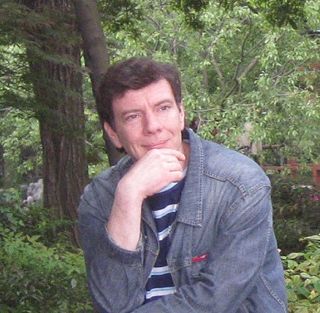Related Research Articles

Melting, or fusion, is a physical process that results in the phase transition of a substance from a solid to a liquid. This occurs when the internal energy of the solid increases, typically by the application of heat or pressure, which increases the substance's temperature to the melting point. At the melting point, the ordering of ions or molecules in the solid breaks down to a less ordered state, and the solid "melts" to become a liquid.

In chemistry, thermodynamics, and many other related fields, phase transitions are the physical processes of transition between a state of a medium, identified by some parameters, and another one, with different values of the parameters. Commonly the term is used to refer to changes among the basic states of matter: solid, liquid, and gas, as well as plasma in rare cases.
The λ (lambda) universality class is a group in condensed matter physics. It regroups several systems possessing strong analogies, namely, superfluids, superconductors and smectics. All these systems are expected to belong to the same universality class for the thermodynamic critical properties of the phase transition. While these systems are quite different at the first glance, they all are described by similar formalisms and their typical phase diagrams are identical.

Polyamorphism is the ability of a substance to exist in several different amorphous modifications. It is analogous to the polymorphism of crystalline materials. Many amorphous substances can exist with different amorphous characteristics. However, polyamorphism requires two distinct amorphous states with a clear, discontinuous (first-order) phase transition between them. When such a transition occurs between two stable liquid states, a polyamorphic transition may also be referred to as a liquid–liquid phase transition.
Extremal optimization (EO) is an optimization heuristic inspired by the Bak–Sneppen model of self-organized criticality from the field of statistical physics. This heuristic was designed initially to address combinatorial optimization problems such as the travelling salesman problem and spin glasses, although the technique has been demonstrated to function in optimization domains.
Harry L. Swinney is an American physicist noted for his contributions to the field of nonlinear dynamics.

Volker Heine FRS is a New Zealand / British physicist. He is married to Daphne and they have three children. Volker Heine is considered a pioneer of theoretical and computational studies of the electronic structure of solids and liquids and the determination of physical properties derived from it.

Michael Thorpe is an English-American physicist and Foundation Professor of Physics at Arizona State University. He received his D. Phil from Oxford University in 1968 in condensed matter physics under supervision of Sir Roger James Elliott. His early research was on network glasses, but has recently focused on applying his knowledge to the study of protein dynamics.
Quantum dimer models were introduced to model the physics of resonating valence bond (RVB) states in lattice spin systems. The only degrees of freedom retained from the motivating spin systems are the valence bonds, represented as dimers which live on the lattice bonds. In typical dimer models, the dimers do not overlap.
In crystallography, a disclination is a line defect in which rotational symmetry is violated. In analogy with dislocations in crystals, the term, disinclination, for liquid crystals first used by Frederick Charles Frank and since then has been modified to its current usage, disclination. It is a defect in the orientation of director whereas a dislocation is a defect in positional order.
The hexatic phase is a state of matter that is between the solid and the isotropic liquid phases in two dimensional systems of particles. It is characterized by two order parameters: a short-range positional and a quasi-long-range orientational (sixfold) order. More generally, a hexatic is any phase that contains sixfold orientational order, in analogy with the nematic phase.
The glass–liquid transition, or glass transition, is the gradual and reversible transition in amorphous materials from a hard and relatively brittle "glassy" state into a viscous or rubbery state as the temperature is increased. An amorphous solid that exhibits a glass transition is called a glass. The reverse transition, achieved by supercooling a viscous liquid into the glass state, is called vitrification.

David Matthew Ceperley is a theoretical physicist in the physics department at the University of Illinois Urbana-Champaign or UIUC. He is a world expert in the area of Quantum Monte Carlo computations, a method of calculation that is generally recognised to provide accurate quantitative results for many-body problems described by quantum mechanics.
Daniel L. Stein is an American physicist and Professor of Physics and Mathematics at New York University. From 2006-2012 he served as the NYU Dean of Science.

David R. Nelson is an American physicist, and Arthur K. Solomon Professor of Biophysics, at Harvard University.

Vladimir G. Dubrovskii is the head of Laboratory of physics of nanostructures at St. Petersburg Academic University, a leading research scientist at Ioffe Institute, and a professor at St. Petersburg State University and ITMO University.
Replica cluster move in condensed matter physics refers to a family of non-local cluster algorithms used to simulate spin glasses. It is an extension of the Swendsen-Wang algorithm in that it generates non-trivial spin clusters informed by the interaction states on two replicas instead of just one. It is different from the replica exchange method, as it performs a non-local update on a fraction of the sites between the two replicas at the same temperature, while parallel tempering directly exchanges all the spins between two replicas at different temperature. However, the two are often used in conjunction to achieve state-of-the-art efficiency in simulating spin-glass models.
Hartmut Löwen is a German physicist working in the field of statistical mechanics and soft matter physics.
In statistical mechanics and condensed matter physics, the Kovacs effect is a kind of memory effect in glassy systems below the glass-transition temperature. A.J. Kovacs observed that a system’s state out of equilibrium is defined not only by its macro thermodynamical variables, but also by the inner parameters of the system. In the original effect, in response to a temperature change, under constant pressure, the isobaric volume and free energy of the system experienced a recovery characterized by non-monotonic departure from equilibrium, whereas all other thermodynamical variables were in their equilibrium values. It is considered a memory effect since the relaxation dynamics of the system depend on its thermal and mechanical history.
References
- 1 2 Newman, C. M.; Stein, D. L. (17 June 1996). "Spatial Inhomogeneity and Thermodynamic Chaos". Physical Review Letters. American Physical Society (APS). 76 (25): 4821–4824. arXiv: adap-org/9511001 . Bibcode:1996PhRvL..76.4821N. doi:10.1103/physrevlett.76.4821. ISSN 0031-9007. PMID 10061389. S2CID 871472.
- ↑ Aizenman, Michael; Wehr, Jan (1990). "Rounding effects of quenched randomness on first-order phase transitions". Communications in Mathematical Physics. Springer Science and Business Media LLC. 130 (3): 489–528. Bibcode:1990CMaPh.130..489A. doi:10.1007/bf02096933. ISSN 0010-3616. S2CID 122417891.
- ↑ Newman, C. M.; Stein, D. L. (1 April 1997). "Metastate approach to thermodynamic chaos". Physical Review E. American Physical Society (APS). 55 (5): 5194–5211. arXiv: cond-mat/9612097 . Bibcode:1997PhRvE..55.5194N. doi:10.1103/physreve.55.5194. ISSN 1063-651X. S2CID 14821724.
- 1 2 Newman, Charles M.; Stein, Daniel L. (1998). "Thermodynamic Chaos and the Structure of Short-Range Spin Glasses". Mathematical Aspects of Spin Glasses and Neural Networks. Boston, MA: Birkhäuser Boston. pp. 243–287. doi:10.1007/978-1-4612-4102-7_7. ISBN 978-1-4612-8653-0.
- ↑ Debenedetti, P.G.Metastable Liquids: Concepts and Principles; Princeton University Press: Princeton, NJ, USA, 1996.
- ↑ Imre, Attila; Wojciechowski, Krzysztof; Györke, Gábor; Groniewsky, Axel; Narojczyk, Jakub. (3 May 2018). "Pressure-Volume Work for Metastable Liquid and Solid at Zero Pressure". Entropy. MDPI AG. 20 (5): 338. Bibcode:2018Entrp..20..338I. doi: 10.3390/e20050338 . ISSN 1099-4300. PMC 7512857 . PMID 33265428.